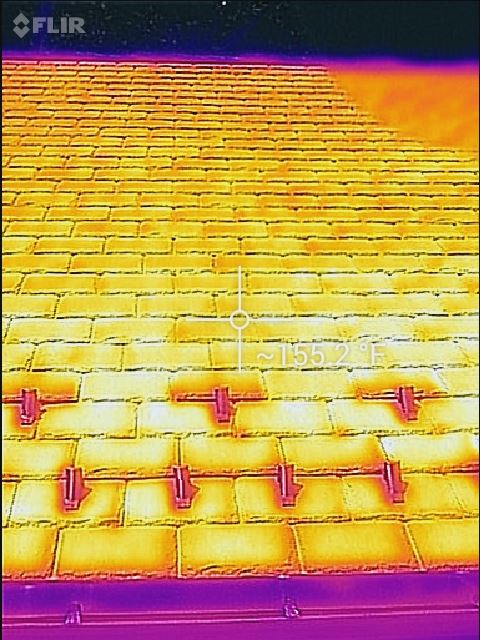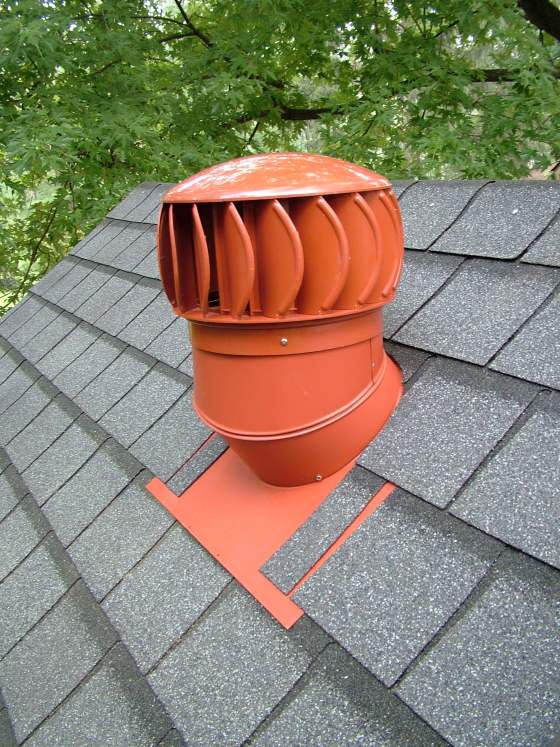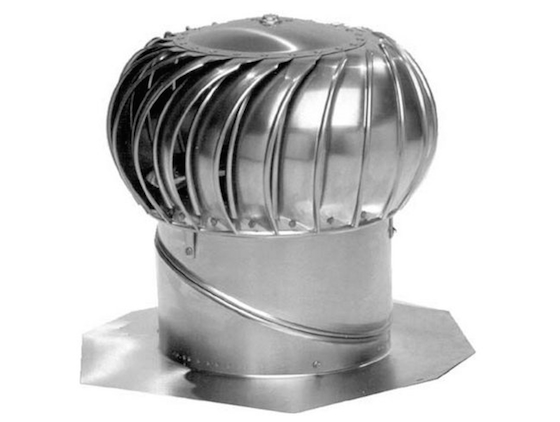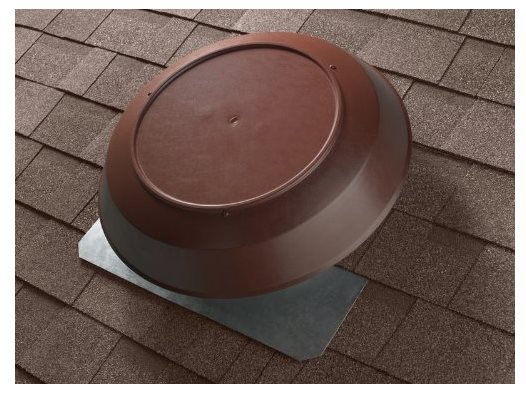Attic Ventilation

Here's an infrared camera photo I snapped of my own roof in July. The temperature was 155 F. That's blistering hot. Copyright 2018 Tim Carter
Attic Ventilation Key Points
- Roofing, lumber and insulation get very hot
- Vast amounts of air must move through attic to try to cool it
- Solar-powered fans are a joke - they don't work well late in the day
- Turbine vents or powered attic fans are best
DEAR TIM: My attic has natural ventilation. Instead of attic ventilation fans, it has triangular vents on the top side walls of my home. How do I know if I have proper attic ventilation?
My attic gets so hot in the summer, you can barely breathe up there. It is impossible to stay up there more than a few minutes. How much soffit ventilation should I have?
What are the best attic ventilation systems to cool my attic naturally without any electric-powered fans? Joel T., Portsmouth, VA
DEAR JOEL: I applaud you for trying to ventilate your attic the old-fashioned way. But without moving massive amounts of air in a short amount of time through your attic space, I doubt you will ever get your attic temperatures cool enough to where to where you can tolerate being up there for an extended amount of time.
I can't think of one natural method of ventilation that will move vast amounts of air from sunrise to several hours past sunset.
Free & Fast Bids
CLICK HERE to get FREE & FAST BIDS from local contractors who can install attic ventilation.
Wide Open Construction Is The Key To Attic Ventilation
Visit a tropical island where the outdoor air temperature gets nearly as hot as where you live, and you will see how islanders have kept cool for generations without electricity. They build wide-open structures that often have no windows.

This turbine vent spins with just the slightest breeze. It is but one tool to use when you want superior attic ventilation. PHOTO CREDIT: Tim Carter
They want the natural breezes to blow through the houses and buildings. This air movement activates natural air conditioning when it blows across the skin of any creature that perspires.
When we sweat, the moisture on our skin picks up the heat from our bodies. As the perspiration evaporates into water vapor, it takes this heat up into the air.
This is why you feel cooler almost immediately when a fan blows across your body and you are sweating, get out of a shower, or from a swimming pool.
Lumber Doesn't Sweat
But lumber and insulation do not have perspiration glands. When the sun beats down on your roof, it absorbs the infrared energy from the sunlight. This heat quickly is transferred to the wood roof sheathing, the framing lumber or trusses, any objects in the attic and the insulation. Yes, insulation gets hot, very hot.
The temperature of the roofing material, the roof sheathing, the roof trusses or framing can quickly exceed 150F in the spring and fall. It can get much hotter in the summer and even in winter roof temperatures on a brilliantly sunny day might approach 100 F.
Roof Framing, Shingles, And Insulation Get VERY Hot
All of these objects radiate the heat just like the glowing coals in a campfire. The only way to lower the attic temperature is to pass air over the lumber and insulation, lots and lots of air. You need to circulate massive quantities of air over anything that is hot because there is no water available to increase the rate of heat transfer.
Traditional static air vents in a roof don't provide enough air movement, and they work solely by convection. This simply means that as the air inside your attic heats up, it tries to float through the static vents. Floating air does not move quickly.
CLICK HERE to get FREE & FAST BIDS from local contractors who can install attic ventilation.
Turbine Vents Can Move Lots of Air
Turbine vents are a great way to move quite a bit of air through your attic, but they only work well when there is a strong, sustained wind blowing outdoors. You can't count on this in all areas of the USA.
Some places do have lots of wind, like the sea coast and land by other large bodies of water, but even then your attic may get so hot five or more turbine vents might not keep up with the heat being generated.

This is a standard turbine vent. They come in different colors. Some have external braces. This one you see is Made in the USA. CLICK THE IMAGE TO ORDER ONE OF THESE GREAT TURBINE VENTS.
The best soffit ventilation is complete wide-open ventilation. The more air you can get moving in from the lower part of the roof the better. You must make sure the air space on top of your exterior walls is not blocked with insulation. This prevents air movement from the soffits into the attic. Some houses do not have roof overhangs or soffits.
Continuous Soffit Vents Are A Must
Air pathways can be built behind the gutter boards or between any gutter and the gutter or fascia board at the bottom of the roof. If building a new home, ask your architect or builder to increase the heel height of the rafters as they pass over the exterior walls.
If you want your attic to be as cool as possible, I am afraid to say you will need electric-powered ventilation.
You need to move thousands and thousands of cubic feet per minute of air through your attic to pull away heat from the roof sheathing, framing timbers and the insulation. Even with the best fans operating at full speed, my guess is you would have a very hard time keeping the attic air temperature much below 115 F.

This is an attic fan powered by electricity. They can move up to 1600 cubic feet of air per minute. Some are more powerful. CLICK THE PHOTO now to have this at your home in days.
If you decide to install electric-powered attic ventilation fans, and you have central air conditioning, it is imperative your soffit ventilation be as open as possible. You need insect screening to ensure birds and insects do not invade your attic. The soffits must be the place the air enters the attic to replace all of the air being discharged by the fans.
If the fans can't satisfy their appetite for air from the soffits, they will begin to draw it from the inside of your home. You will be sending expensive air-conditioned air from your living areas into your attic. This is a very bad idea, and it can hurt you financially.
Air leaks from your home up into your attic can be found fairly quickly if you have fiberglass insulation. Pull back batts and look for dirty spots in the insulation. This is often dirt that is in the air coming from your home. The fiberglass batts act just like a furnace air filter.
CLICK HERE to get FREE & FAST BIDS from local contractors who can install attic ventilation.
Column 683

9 Responses to Attic Ventilation